
HMAS Success was a Durance-class multi-product replenishment oiler that previously served in the Royal Australian Navy (RAN). Built by Cockatoo Docks & Engineering Company in Sydney, Australia, during the 1980s, she is the only ship of the class to be constructed outside France, and the only one to not originally serve in the Marine Nationale. The ship was part of the Australian contribution to the 1991 Gulf War, and was deployed to East Timor in response to incidents in 1999 and 2006. The ship was fitted with a double hull during the first half of 2011, to meet International Maritime Organization standards.
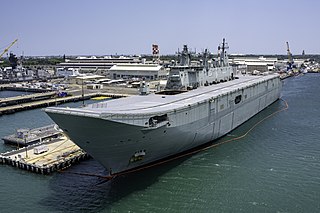
The Canberra class is a ship class of two landing helicopter dock (LHD) ships built for the Royal Australian Navy (RAN). Planning to upgrade the navy's amphibious fleet began in 2000, based on Australian experiences leading the International Force for East Timor peacekeeping operation. With a new climate for growing Australian Navy spending, a desire existed for forward defence capability for landing and supporting troops on Asian territory, that had never existed in Australian history, even with the old Majestic-class light fleet carriers, HMAS Melbourne and HMAS Sydney in the 1970s. In 2004, French company Direction des Constructions Navales (DCN) and Spanish company Navantia were invited to tender proposals, with DCN offering the Mistral-class amphibious assault ship and Navantia proposing the "Buque de Proyección Estratégica" design. The Spanish design was selected in 2007, with Navantia responsible for construction of the ships from the keel to the flight deck, and BAE Systems Australia handling the fabrication of the combat and communications systems. Finally, Siemens (Germany) supplied and fitted the azimuth thrusters.

HMAS Sirius was a commercial tanker purchased by the Royal Australian Navy and converted into a fleet replenishment vessel to replace HMAS Westralia. She was named in honour of HMS Sirius of the First Fleet. Launched in South Korea on 2004, and converted in Western Australia, Sirius was commissioned in 2006; three years before a purpose-built vessel would have been built, and at half the cost. The tanker was decommissioned in 2021 and subsequently scrapped.

The Pacific class is a class of 22 patrol boats built by Australia and donated to twelve South Pacific countries. They were constructed between 1985 and 1997 and are operated by militaries, coast guards or police forces of twelve island nations. These boats are supported by the Pacific Patrol Boat Program and used primarily for maritime surveillance and fisheries protection.

HMAS Albany, named for the city of Albany, Western Australia, is an Armidale-class patrol boat of the Royal Australian Navy (RAN).

HMAS Pirie, named for the city of Port Pirie, South Australia, is an Armidale-class patrol boat of the Royal Australian Navy (RAN).

HMAS Bundaberg, named after the city of Bundaberg, was an Armidale class patrol boat of the Royal Australian Navy (RAN). The ship was built in Henderson, Western Australia, and was commissioned into the RAN in March 2007. Based at HMAS Cairns, Bundaberg spent much of her career deployed as part of border protection and fisheries protection patrols as part of Operation Resolute. In addition, the patrol boat was involved in several national and multinational training exercises, visited Vanuatu in 2011, tracked a suspected drug-smuggling vessel that led to a multimillion-dollar seizure, and participated in the International Fleet Review 2013. In August 2014, a large fire broke out on the ship while she was undergoing refit. Extensive damage from the fire led to the ship's decommissioning in December 2014.

The Bay class is a class of eight armed patrol boats, built by Austal and used by the Customs Marine Unit of the Australian Customs and Border Protection Service. They entered service during the late 1990s and early 2000s, and are primarily used on border protection duties.
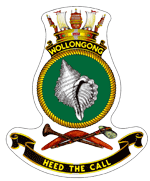
HMAS Wollongong, named for the city of Wollongong, was an Armidale-class patrol boat of the Royal Australian Navy (RAN).

The Marine Unit, formerly the Australian Customs Service National Marine Unit, is a division of the Australian Border Force which acts as a Coast Guard in guarding Australia's coast. The Marine Unit focuses on surveillance and response activities within the Australian Economic Exclusion Zone, and the operation and training of ships and crews to do so.
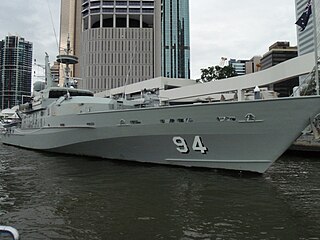
HMAS Launceston is an Armidale-class patrol boat of the Royal Australian Navy (RAN).

The MV Oceanic Viking was an armed patrol vessel of the Australian Customs Service. Originally built in 1996 as the offshore supply vessel Viking Lady for Norwegian shipping company Eidesvik Shipping AS, the ship was converted into a cable layer in 2000 and renamed Oceanic Viking. The ship was chartered to the Australian Customs Service through P&O Marine Services from 2004 to 2010. In 2011, it was purchased by A&P Tyne, Isle of Man, and renamed European Supporter.
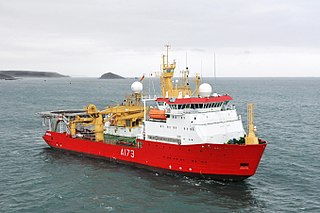
HMS Protector is a Royal Navy ice patrol ship built in Norway in mid 2000. As MV Polarbjørn she operated under charter as a polar research icebreaker and a subsea support vessel. In 2011, she was chartered as a temporary replacement for the ice patrol ship HMS Endurance and was purchased by the British Ministry of Defence in early September 2013. As DNV Ice Class 05 the vessel can handle first year ice up to 0.5 metres (20 in).
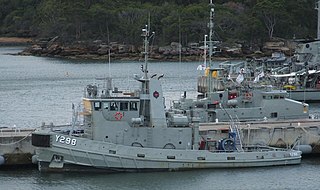
The Bandicoot class was a ship class of two minesweeper tugboats operated by the Royal Australian Navy (RAN). MSA Bandicoot and MSA Wallaroo were built in 1982 for Maritime (PTE) Ltd. as the tugboats Grenville VII and Grenville V. In 1990, the RAN purchased the vessels for conversion into auxiliary minesweepers under the Craft of Opportunity Program (COOP). The vessels could be equipped with a sidescan sonar and various towed minesweeping arrays, and also functioned as berthing tugs. Both vessels were placed in reserve in 2010, but were deployed on several occasions since to provide berthing support to nuclear-powered warships. They were removed from naval service in 2014.

Australian Border Force Cutter (ABFC) Ocean Shield is an offshore patrol vessel operated by the Australian Border Force. The ship was originally ordered in 2010 by DOF Subsea as an offshore support vessel, and was laid down by STX OSV as MSV Skandi Bergen in 2011. In 2012, the Australian Department of Defence was seeking a short-term replacement for the decommissioned Kanimbla-class amphibious landing ships, and negotiated to purchase the under-construction Skandi Bergen from DOF Subsea. The ship was completed, and entered Royal Australian Navy (RAN) service in mid-2012 as the civilian-crewed Australian Defence Vessel (ADV) Ocean Shield.

The Cape class is a ship class of 22 large patrol boats operated by the Marine Unit of the Australian Border Force, the Royal Australian Navy (RAN) and the Trinidad and Tobago Coast Guard. Ordered in 2011, the vessels were built by Austal to replace Customs' Bay-class patrol boats, and entered service from 2013 onwards. Following availability issues with the Armidale class, two vessels were chartered by the RAN from mid-2015 to late 2016. A further two vessels were ordered at the end of 2015 by the National Australia Bank, who will charter the patrol boats to the Department of Defence from completion in 2017. 2 vessels were ordered by Trinidad and Tobago for their coast guard in 2018 with the vessels delivered in 2021. The RAN placed an order for six 'Evolved' Cape-class vessels in 2020, a second order in 2022 for an additional two vessels, and a third order in 2023 for a further two vessels.
Two ships have been named Skandi Bergen:
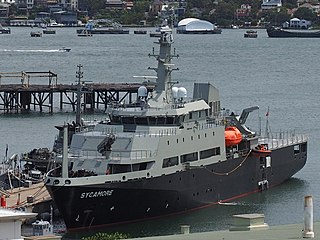
MV Sycamore is a training ship built to support the Royal Australian Navy (RAN) by Netherlands shipbuilders Damen Group. The vessel was built in Damen's shipyard in Haiphong, Vietnam and launched in 2016. The ship is operated for the RAN by Teekay Australia and entered service in 2017.

Horizon Arctic is an anchor handling tug supply vessel (AHTS) completed in 2016 by Vard Group at its Brattvåg shipyard as Bourbon Arctic for Bourbon Offshore Norway AS, part of the Marseille-based Bourbon group. As of 2023, it is operated by Horizon Maritime of Canada. Under Horizon, it served as the surface support vessel for the Titan submersible during its 2021 and 2022 survey expeditions to the wreck of the Titanic, conducted by OceanGate.


















